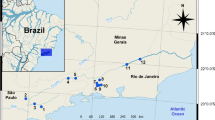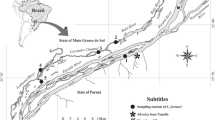Abstract
The Asian kelp Undaria pinnatifida was first reported in north-western Spain in 1988. Since then, it has spread along the Galician coasts and towards the western Cantrabrian coast, probably supported by new introductions related to aquaculture and private yachts. Despite the high potential of this seaweed to invade new areas, it has not fully established itself in specific areas along the eastern Cantabrian coast where it has been farmed. We attempted to identify the macro-environmental determinants for the successful establishment of U. pinnatifida in the northern Iberian coast. Thus, we built a model based on the significant relationships between this kelp and several environmental factors using the Favourability Function, a method based on binary logistic regression. We obtained a statistically significant Favourability model where the chlorophyll concentration in summer was the most influential variable and the photosynthetically active radiation in spring was a secondary variable that best characterized the presence of U. pinnatifida. The ecological implications are discussed.


Similar content being viewed by others
References
Akaike H (1973) Information theory and an extension of the maximum likelihood principle. In: Petrov BN, Csaki F (eds) Proceedings of the second international symposium on information theory, Akademiai Kiado, Budapest, Hungary, pp 267–281
Akiyama K (1965) Studies of ecology and culture of Undaria pinnatifida (Harvey) Sur. II. Environmental factors affecting the growth and maduration of gametophyte. Bull Tohoku Reg Fish Res Lab 25:143–170
Akiyama K, Kurogi M (1982) Cultivation of Undaria pinnatifida (Harvey) Suringar, the decrease in crops from natural plants following crops increase from cultivation. Bull Tohoku Reg Fish Res Lab 44:91–100
Álvarez C, Coma JE, Lucena C, Porras J, San José MA, Quang N (1979) Mapa hidrogeológico Nacional Explicación de los mapas de lluvia útil e reconocimiento hidrogeológico y de síntesis de los sistemas acuíferosd. Instituto Geológico y Minero de España, Madrid, 46 pp
Araujo R, Bárbara I, Tibaldo M, Berecibar E, Díaz-Tapia P, Pereira R, Santos R, Sousa-Pinto I (2009) Checklist of benthic marine algae and cyanobacteria of northern Portugal. Bot Mar 52:24–46
Báez JC, Real R, Vargas JM, Flores-Moya A (2004) A biogeographic analysis of the genera Audouinella (Rhodophyta), Cystoseira (Phaeophyceae) and Cladophora (Chlorophyta) in the western Mediterranean Sea and Adriatic Sea. Phycologia 43:404–415
Báez JC, Real R, Vargas JM, Flores-Moya A (2005) Chorotypes of seaweeds from the western Mediterranean Sea and the Adriatic Sea: An analysis based on the genera Audouinella (Rhodophyta), Cystoseira (Phaeophyceae) and Cladophora (Chlorophyta). Phycol Res 53:255–265
Bárbara I, Cremades J, Calvo S, López-Rodríguez MC, Dosil J (2005) Checklist of the benthic marine and brackish Galician algae (NW Spain). Anales Jard Bot Madrid 62:69–100
Bárbara I, Díaz P, Araújo R, Peña V, Berecibar E, Cremades J, Freire Ó, Baamonde S, Novo T, Calvo S, López-Rodríguez MC, Afonso-Carrillo J, De Clerck O, Santos R, Sousa-Pinto I, Tibaldo M, Lagos V, López C, Sencilla A, Santolaria A, Díez I, Veiga AJ (2006) Adiciones corológicas y correcciones a la flora bentónica marina del norte de la Península Ibérica. Nova Acta Cient. Compost. (Bioloxía) 15:77–88
Benjamini Y, Hochberg Y (1995) Controlling the false discovery rate: a practical and powerful approach to multiple testing. J R Stat Soc B 57:289–300
Burnham KP, Anderson DR (2002) Model selection and multimodel inference: a practical information-theoretic approach, 2nd edn. Springer, NY, p 488
Campbell SJ, Bit JS, Burridge TR (1999) Seasonal patterns in the photosynthetic capacity, tissue pigment and nutrient content of different developmental stages of Undaria pinnatifida (Phaeophyta: Laminariales) in Port Phillip Bay, South-Eastern Australia. Bot Mar 42:231–243
Castric-Fey A, Beaupoil C, Bouchain J, Pradier E, L’Hardy-Halos MT (1999a) The introduced alga Undaria pinnatifida (Laminariales, Alariaceae) in the rocky shore ecosystem of the St. Malo area: morphology and growth of the sporophyte. Bot Mar 42:71–83
Castric-Fey A, Girard A, L`Hardy-Halos MT (1999b) The introduced alga Undaria pinnatifida (Laminariales, Alariaceae) in the rocky shore ecosystem of the St. Malo area: growth rate and longevity of the sporophyte. Bot Mar 42:83–96
Cecere E, Petrocelli A, Saracino OD (2000) Undaria pinnatifida (Fucophyceae, Laminariales) spread in the central Mediterranean: its occurrence in the Mar Piccolo of Taranto (Ionian Sea, southern Italy). Cryptogamie Algol 21:305–309
Cheney DF (1977) R+C/P, a new and improved ratio for comparing seaweed floras. J Phycol 13:1–12
Courchamp F, Clutton-Brock T, Grenfell B (1999) Inverse density dependence and the allee effect. Trends Ecol Evol 14:405–410
Cremades J, Freire-Gago Ó, Peteiro C (2006) Biología, distribución e integración del alga alóctona Undaria pinnatifida (Laminariales, Phaeophyta) en las comunidades bentónicas de las costas de Galicia (NW de la Península Ibérica). Anales Jard Bot Madrid 63:169–187
Curiel D, Bellemo G, Marzocchi M, Scattolin M, Parisi G (1998) Distribution of introduced Japanese macroalgae Undaria pinnatifida, Sargassum muticum (Phaeophyta) and Antithamnion pectinatum (Rhodophyta) in the Lagoon of Venice. Hydrobiologia 385:17–22
Daehler CC, Carino DA (2000) Predicting invasive plants: prospects for a general screening system based on current regional models. Biol Invasions 2:93–102
Davis M, Grime JP, Thompson K (2000) Fluctuating resources in plant communities: a general theory of invasibility. J Ecol 88:528–534
ES IC (2007) Alien species alert: Undaria pinnatifida (wakame or Japonese kelp). ICES Cooperative Res 283:1–36
Feldmann J, Lami R (1941) Flore et vegetation marines de la côte Basque Françoise. B Soc Bot Fr 88:123–142
Fielding AH, Bell JF (1997) A review of methods for the assessment of prediction errors in conservation presence/absence models. Environ Conserv 24:38–49
Floc′h JY, Pajot R, Wallentinus I (1991) The Japanese brown alga Undaria pinnatifida on the coast of France and its possible establishment in Europe waters. J Cons Int Explor Mer 47:379–390
Font I (2000) Climatología de España y Portugal. Universidad de Salamanca, Salamanca, p 422
García LV (2003) Controlling the false discovery rate in ecological research. Tree 18:553–554
Gil J (2008) Macro and mesoscale physical patterns in the Bay of Biscay. J Mar Biol Ass UK 88:217–225
IGN (1999) Mapa de Carreteras: Península Ibérica, Baleares y Canarias. Instituto Geográfico Nacional. Ministerio de Fomento, Madrid
Gorostiaga JM, Santolaria A, Secilla A, Casares C, Díez I (2004) Check-list of the Basque coast benthic algae (North of Spain). Anales Jard Bot Madrid 61:155–180
Heger T, Trelp L (2003) Predicting biological invasions. Biol Invasions 5:313–321
Hosmer DW, Lemeshow S (2000) Applied logistic regression, 2nd edn. Wiley, New York, p 375
Hutchinson GE (1959) Homage to Santa Rosalía, or why are there so may kinds of animals? Am Nat 93:145–159
Keeley JE, Baer-Keeley M, Fotheringham CJ (2005) Alien plant dynamics following in mediterranean-climate California shrublands. Ecol Appl 15:2109–2125
Larson DL, Anderson PL, Newton W (2001) Alien plant invasion in mixed-grass praire: effects of vegetation type and antropogenic disturbance. Ecol Appl 11:128–141
Lobban CS, Harrison PJ (2000) Seaweed ecology and physiology. Cambridge University Press, Cambridge, 366 pp
Lobo J, Jiménez-Valverde A, Real R (2008) AUC: a misleading measure of the performance of predictive distribution models. Global Ecol Biogeogr 17:145–151
López-Darías M, Lobo JM, Gouat P (2007) Predicting potencial distributions of invasive species: the exotic Barbary ground squirrel in the Canarian archipelago and the best Mediterranean region. Biol Invasions. doi: 10.1007/s10530-007-9181-2
Lünning F (1990) Seaweeds: their environment, biogeography and ecophysiology. Wiley, New York, 527 pp
Mann KH, Lazier JRN (1991) Dynamics of marine ecosystems. Biological-physical interactions in the oceans. Blackwell Scientific Publications, New York, 512 pp
Martínez-Gil M, Gallardo T, Díaz P, Bárbara I (2007) Aportaciones al conocimineto de las algas marinas bentónicas del litoral comprendido entre el estuario del río Quejo y Punta de la Mesa, Noja, Cantabria, España. Bot Complot 31:41–53
Morita T, Kurashima A, Maegawa M (2003a) Temperature requirements for the growth and maturation of the gametophytes of Undaria pinnatifida and U. undarioides (Laminariales, Phaeophyceae). Phycol Res 51:154–160
Morita T, Kurashima A, Maegawa M (2003b) Temperature requirements for the growth of young sporophytes of Undaria pinnatifida and Undaria undarioides (Laminariales, Phaeophyceae). Phycol Res 51:265–270
Muñoz AR, Real R (2006) Assessing the potential range expansion of the exotic monk parakeet in Spain. Divers Distrib 12:656–665
Parker JD, Burkepile DE, Hay ME (2006) Opposing effects of native and exotic herbivores on plant invasions. Sci Pêche 311:1459–1461
Pérez-Ruzafa I, Menéndez J, Salinas JM (2002) Mapas de distribución de algas marinas de la Península Ibérica e Islas Baleares. XV. Undaria pinnatifida (Harvey) Suringar (Laminariales, Phucophyceae). Bot Complot 26:147–151
Peteiro C (2008) A new record of the introduced seaweed Undaria pinnatifida (Laminariales, Phaeophyceae) from the Cantabrian Sea (northern Spain) with comments on its establishment. Aquat Invasions 3(4):359–361
Peterson AT, Vieglais DA (2001) Predicting species invasions using ecological niche modeling: new approaches from bioinformatics attack a pressing problem. Bioscience 51:363–371
Ramírez-Félix E, Manzo-Monroy HG (2004) Modelling the use of two fishery access rights, concessions and licences, in the red sea urchin, Strongylocentrotus franciscanus (Agassiz), fishery at Santo Tomás, Baja California, Mexico. Cienc Mar 30:547–560
Real R, Vargas JM, Antúnez A (1993) Environmental influences on local amphibian diversity: the role of floods on river basins. Biodivers Conserv 2:376–399
Real R, Barbosa AM, Vargas JM (2006) Obtaining environmental favourability functions from logistic regression. Environ Ecol Stat 13:237–245
Real R, Márquez AL, Estrada A, Muñoz AR, Vargas JM (2008) Modelling chorotypes of invasive vertebrates in mainland Spain. Divers Distrib 14:364–373
Saito Y (1975) Undaria. In: Tokida J, Hirose H (eds) Advance in phycology in Japan. Dr. W. Junk, Hague, pp 304–320
Salinas JM, Llera EM, Fuertes C (1996) Nota sobre la presencia de Undaria pinnatifida (Harvey) Suringar (Laminariales, Phaeophyta) en Asturias (mar Cantábrico). Bol Inst Esp Oceanogr 12:77–79
Santiago Caamaño J, Durán Neira C, Acuña Castroviejo R (1990) Aparición de Undaria pinnatifida en las costas de Galicia (España). Un nuevo caso en la problemática de introducción de especies foráneas. Informes Técnicos CIS 3:1–43
Sauvageau C (1897) Note préliminaire sur les algues marines du Golfe de Gascogne. J Bot 11:1–64
Tobin PC, Whitmire SL, Johnson DM, Bjørnstad ON, Liebhold AM (2007) Invasion speed is affected by geographical variation in the strength of allee effects. Ecol Lett 10:36–43
Valentine JP, Johnson CR (2003) Establishment of the introduced kelp Undaria pinnatifida in Tasmania depends on disturbance to nativa algal assemblages. J Exp Mar Biol Ecol 295:63–90
Valentine JP, Magierowski RH, Johnson CR (2007) Mechanisms of invasion: establishment, spread and persistence of introduced seaweed populations. Bot Mar 50:351–360
van den Hoek C, Donze M (1966) The algal vegetation of the rocky cote Basque (SW France). Bull Centr Etud Rech Sci Biarritz 6:289–319
Wright GH (1983) Species-energy theory: an extension to species-area theory. Oikos 41:496–506
Zuur AK, Ieno EN, Smith GM (2007) Analysing ecological data. Springer, New York, 672 pp
Acknowledgments
We are grateful to Ignacio Bárbara and Óscar Freire for providing us with access to the Undaria pinnatifida data stored in the SANT-algae Herbarium (Index Herbariorum code). This work has been partially financed by project CGL2006-09567/BOS (Ministerio de Educación y Ciencia, Spain, and FEDER funds). We also thank to Dr. Daniel Simberloff and one anonymous referee their comments.
Author information
Authors and Affiliations
Corresponding author
Rights and permissions
About this article
Cite this article
Báez, J.C., Olivero, J., Peteiro, C. et al. Macro-environmental modelling of the current distribution of Undaria pinnatifida (Laminariales, Ochrophyta) in northern Iberia. Biol Invasions 12, 2131–2139 (2010). https://doi.org/10.1007/s10530-009-9614-1
Received:
Accepted:
Published:
Issue Date:
DOI: https://doi.org/10.1007/s10530-009-9614-1




